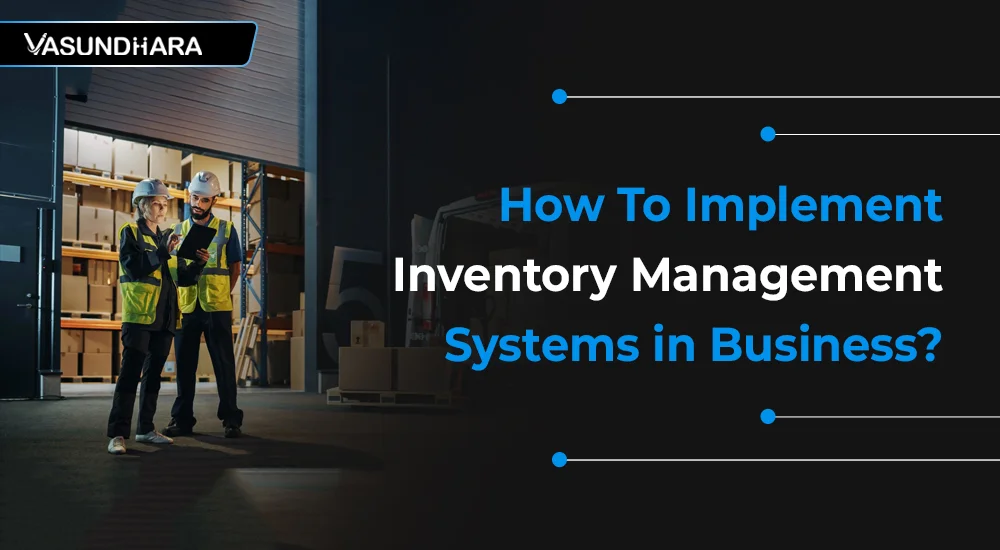How To Implement Inventory Management Systems in Business?


- Jun 27, 2023
In the ever-expanding global economy, finalized products, raw materials, and other components of an entity's inventory-intensive businesses like retail, hospitality, and manufacturing comprise its business in the increasing global economy.
Thus, a key inventory deficit can ruin a corporation. Inventory is an asset and a liability. Stock may spoil, be stolen, damaged, or influenced by demand swings.
Therefore, it is essential to guarantee that the inventory is adequately insured. If a retailer is unable to sell its inventory in a timely manner, it may be compelled to destroy it or sell it at throw-away prices.
Therefore, it is essential for businesses in other industries to develop and employ effective inventory management strategies.
In this article, we discuss recommended practices for how to implement inventory management systems.
These strategies will help you in reducing losses and increasing your overall profitability.
Every company that handles stock needs inventory operations to establish a balance between having too much inventory, which wastes money, and not enough, which causes customer service issues.
Inventory management includes maintaining and recording inventory across all locations as well as projecting future inventory demands.
It also allows you to determine appropriate inventory levels, monitor stock levels, and modify inventory accordingly.
Inventory management also entails keeping the warehouse organized and storing products in the correct spot.
Inventory management is an essential component of every company that sells tangible goods or services.
An effective inventory management strategy guarantees that the appropriate quantities of stock are available at the appropriate time while minimizing costs.
It also contributes to ensuring that clients receive their orders on time and are satisfied with the product or service they receive.
Following confirmation and verification of the received items, it is time to arrange and store them.
At this point, it is critical to think carefully about product storage because there are numerous solutions accessible.
Techniques used in warehouse slotting, such as grouping things according to their SKUs and the categories into which they fall, could be beneficial.
It is also critical to keep best-selling commodities at convenient places to reduce the amount of travel time required to reach them.
Setting up an inventory control system is the next phase in the inventory process. This system should comprise the methods and processes for tracking and monitoring inventories.
These inventory control strategies will enable you to monitor and review inventory levels on a regular basis.
You can also change inventory levels as needed to ensure that their inventory is correct and up to date.
The accessible data will also assist you in precisely forecasting client demand and avoiding overstocking or understocking.
Furthermore, the inventory control method can be used to identify any inconsistencies or discrepancies in the inventory count, as well as any broken or outdated items, as well as any other issues that may be affecting inventory levels.
After identifying the issues, you can take any necessary corrective action.

Following a buyer's purchase, the next step is to precisely and swiftly execute the order's fulfillment obligations, which include packaging and shipping.
If the second and third stages of the inventory procedure are optimized, it should not be too difficult to locate the precise product ordered from storage.
When it comes to product packaging, the consumer experience, durability, and sustainability are all important elements to consider.
When you have finished processing the order and have delivered the delivery, you can send the buyer a confirmation email with tracking information.
The final phase in the inventory management process is to update and replace inventory information.
If you have inventory management software installed, the inventory data will be immediately updated following the transaction.
You can then use the information to place a restocking order with the provider.
The following are some of the reasons why businesses should implement appropriate inventory management systems:
More organized warehouse
An effective inventory management system can assist your company in maintaining a better organized warehouse.
An organization with a disorganized warehouse facility might make working in the procurement and supplies department extremely challenging.
A disorganized warehouse will eventually reduce your production efficiency.
Proper inventory management is critical to acquiring and retaining customers. That is beyond a doubt.
Customer loyalty is something that every business strives for, especially when it comes to brand building and identity.
Organizations that want to keep their customers coming back for more must have the will and capacity to meet their frequently changing demands over time.
A strong stock management system can assist you in determining how much inventory your company should keep on hand.
It can assist prevent product shortages and also allow you to keep appropriate supply without having too much stock in the warehouse.
Remember that having extra warehouse space is just as crucial as not running into product shortages.

Computer software, barcode scanners, and other inventory management systems can boost productivity and efficiency dramatically.
The tools can help to reduce or eliminate the need for manual processes. As a result, staff may focus on more significant and pressing issues affecting the organization.
Good inventory management can provide considerable financial and time savings.
By taking real-time stock of all products that you have ordered as well as stock-at-hand, you may avoid the need to recount stock to assure the correctness of records.
A smart plan can also help you save time and money that might otherwise be spent on slow-moving or unpopular products, and it can also support your market expansion strategy.
>Here are a few of the most common inventory management issues and how the correct inventory solution can assist in resolving them.
Purchasing goods without first selling the existing stock can dramatically reduce your company's earnings.
This problem emerges as a result of poor stock control and management by managers.
When accomplished manually, a few items are not accounted for, and purchasing the same supplies repeatedly reduces profit.
Inventory managers can execute frequent stock audits to detect utilized and unused supplies and enhance inventory efficiency with a stock auditing system in place.
As a result, your company will be able to save time and money while increasing profits.
Consider the challenges in locating or recognising stocks in your inventory - you won't be able to transport the stock on time, which could harm your company's reputation.
An insufficient, inaccurate, or difficult-to-find inventory will only harm your company's bottom line.
Implementing a real-time inventory management system on your premises will not only allow you to locate stocks promptly, but will also provide you with complete location data and stock availability with 100% accuracy.
Managing a large inventory via manual paper-based techniques will not help your firm expand.
As sales volume increases and inventory expands, the lack of digitization and inefficient inventory management processes yield poor results.
An IoT-enabled inventory management system will assist your warehouse workers in efficiently managing inventories and tracking them from the time they enter until they depart your premises. Having an inventory management system will streamline the process, provide you with real-time data, and greatly enhance your inventory efficiency.

The primary cause of this problem is the absence of a system for tracking in-store products/equipment.
Finding a certain product for sale from the inventory frequently consumes a large amount of time for the workforce, and it is incredibly difficult to discover a product among 1000s stored.
Incorrect material selection not only slows sales but also has an impact on client satisfaction
Tagging each product with a laser-etched QR-code, RFID tag, or barcode will assist the workforce in identifying any product among numerous.
All the employees need is a scanner. When the scanner comes into contact with the product, an indicator lamp illuminates.
The product is simply found and passed on to the sales team by the workers. This saves time and enhances the sales cycle as well as customer happiness.
Maintaining a strong inventory is critical for timely delivery of supplies. Defective inventory and waste as a result of inexperienced operators' non-standard methods.
The costs of inventory waste and faults are enormous, and they frequently result in dissatisfied customers.
Your company can manage inventory more effectively with well-established inventory management software.
Streamlined procedures and processes will simplify the task of the personnel while also assisting the organization in managing staff efficiently.
In 2011, Apple CEO Tim Cook inherited a well-established and efficient supply chain. Cook vowed to improve it. He wanted an agile, responsive, and cost-effective supply chain.
Cook simplified the supply chain. He simplified the procedure by removing steps. He also adopted just-in-time inventory management to lower Apple's inventory expenses and improve customer service.
Cook then improved Apple's supplier relations. Apple benefited from his excellent supplier relationships. He also made sure Apple's suppliers were reliable and high-quality.
They took several steps to lessen Apple's environmental effect. He encouraged suppliers to use renewable energy to lower the company's carbon footprint. He promoted recycling and reduced trash.
Apple's annual inventory peaked in 2017 at $4.8 billion. In 2018, the company had an 18.52% year-over-year decline, but they soon recovered, and they had $3.8 billion in inventory in 2019, a 3.79% rise over 2018.
Tim Cook has made Apple's supply chain the world's most efficient and cost-effective. His ideas have kept Apple competitive in a fast-changing market and lucrative.
Inventory management systems allow you to regulate and improve stock practices in your business.
It increases employee productivity by saving them time and effort. Your customers are pleased since the desired things are constantly available.
And your firm thrives and grows, keeping you several steps ahead of your competitors who do not have modern inventory tools.
With all of the facts previously discussed in mind, you already understand how a perfect solution should look, what benefits it will bring to your organization, and how to develop an inventory system that will actually work.
If you are interested in implementing automated inventory management for your business, our team of skilled developers at Vasundhara Infotech is here to assist you.
Please do not hesitate to contact us if you have any queries about designing and implementing the ideal inventory management solution for your needs.
Let's talk about any concerns you have during a free consultation with one of our specialists.
Copyright © 2025 Vasundhara Infotech. All Rights Reserved.
